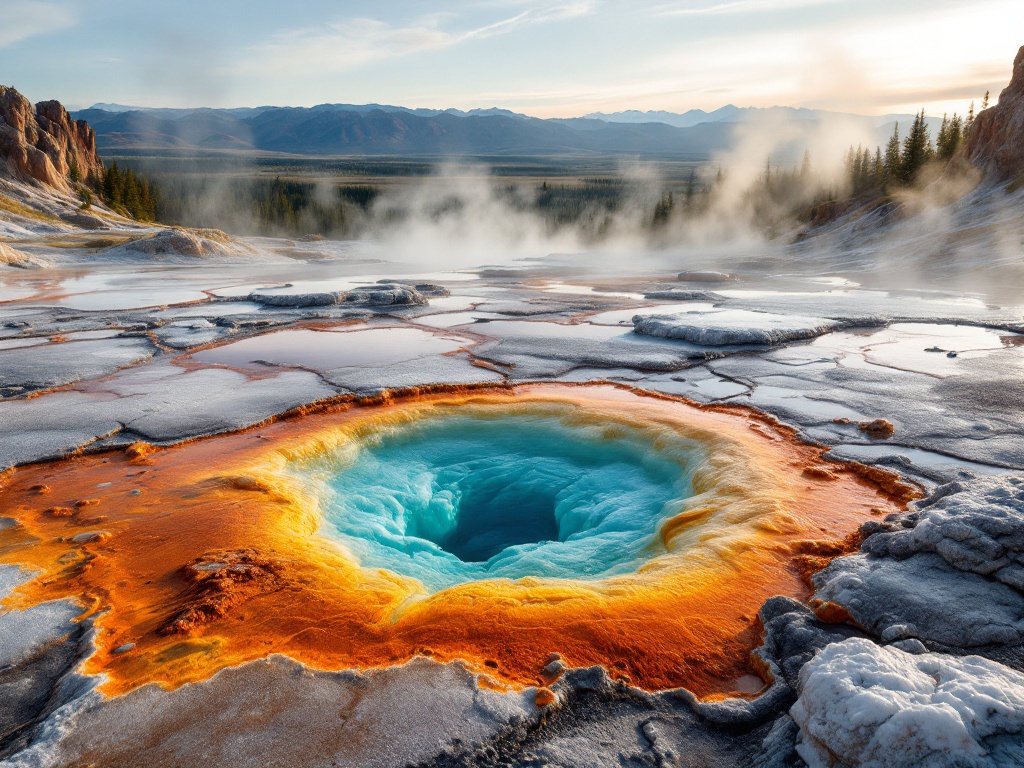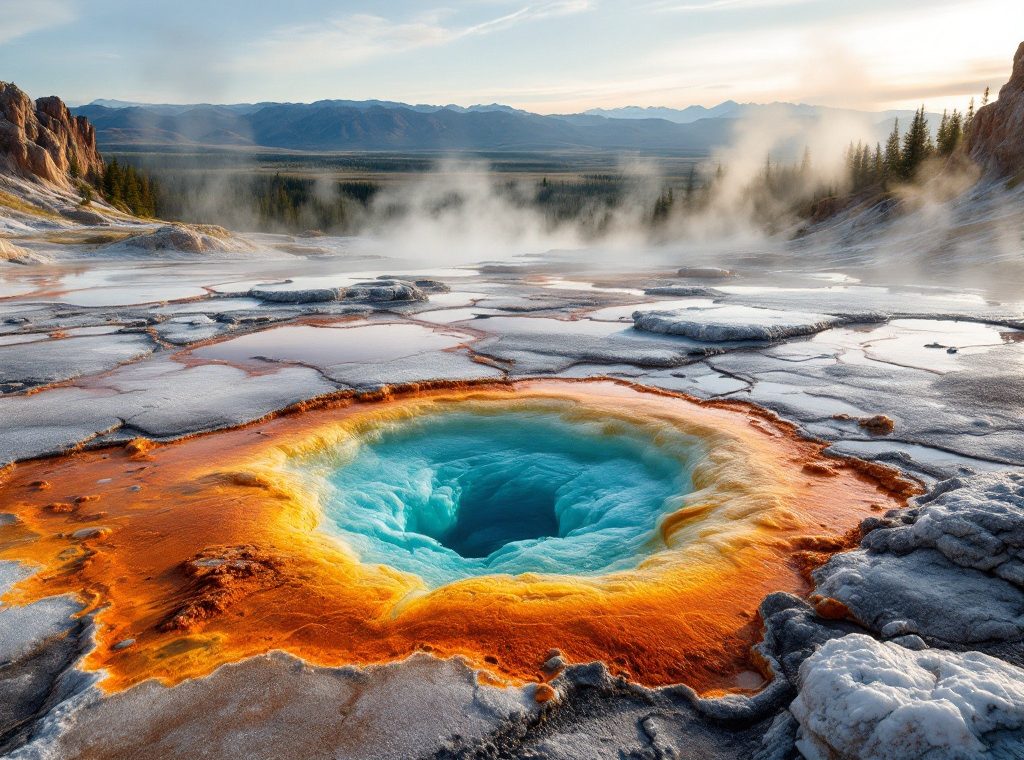Natural Wonders and Science: Exploring Geothermal Parks and Volcanic Sites
Journey into the heart of Earth’s raw power at geothermal parks and volcanic sites! Witness the spectacular displays of geysers, hot springs, and unique volcanic formations. These wonders, fueled by the interaction of magma and groundwater, offer invaluable insights into geology and unique ecosystems. Explore Iceland’s Reykjanes Peninsula and Yellowstone National Park’s geothermal marvels. Discover how these sites contribute to research, education, tourism, and even sustainable energy solutions. Embark on an unforgettable adventure and uncover the secrets of our planet’s fiery depths!
Important information

- Geothermal parks showcase Earth’s power with hot springs, geysers, and unique volcanic formations, driven by magma heating groundwater.
- Geothermal energy offers sustainable power and heating. Iceland uses this resource extensively, reducing reliance on fossil fuels.
- Geothermal areas create unique ecosystems. Extremophile organisms thrive in these extreme conditions, adding to biodiversity.
- Yellowstone National Park and Iceland are key locations for observing geothermal wonders. They offer diverse examples of geothermal activity.
- Careful monitoring of geothermal areas is crucial. It helps manage resources, predict volcanic eruptions, and protect surrounding ecosystems.
Introduction to Geothermal Parks and Volcanic Sites
Geothermal parks and volcanic sites offer a glimpse into the Earth’s raw power. These remarkable areas showcase geothermal activity, allowing visitors to witness hot springs, geysers, and unusual volcanic formations. Often located near active volcanoes, these parks feature fascinating surface phenomena created by magma heating groundwater. Important for research, education, and tourism, they provide insights into the Earth’s geology and unique ecosystems while also supporting local economies. A visit offers a truly unique and educational experience.
Geothermal Features and Their Formation
Geothermal wonders arise from the interaction of magma and groundwater. Deep within the Earth, magma heats the groundwater, causing it to rise and create fascinating geothermal features. These features include hot springs, geysers, fumaroles, and mud pots. The specific type of feature depends on factors such as water temperature, pressure, and the surrounding rock type.
Geysers
Geysers erupt dramatically when superheated water and steam, trapped underground, build pressure and suddenly release. This results in a spectacular display of water and steam shooting into the air.
Hot Springs
Hot springs continuously discharge heated water. They offer a relaxing and therapeutic experience, often rich in minerals.
Mud Pots
Mud pots form when acidic gases mix with surface rocks and water. This creates a bubbling blend of mud and clay, a unique geothermal feature.
Fumaroles
Fumaroles release steam and volcanic gases like sulfur dioxide and carbon dioxide directly from the Earth’s interior. They offer a glimpse into the Earth’s volcanic activity.
Subsurface Magma and Groundwater Interaction
Geothermal wonders, such as geysers and hot springs, are formed by magma’s heat transforming underground water. Hot springs continuously release warm, mineral-rich flows. Geysers, on the other hand, offer a dramatic spectacle. Their eruptions are caused by a buildup of pressure from superheated water. When this pressure surpasses a certain limit, the geyser erupts in a spectacular display.
The Science of Hot Springs and Mudpots
Geothermal activity creates hot springs by heating groundwater and forcing it upwards through fissures in the earth’s surface. Mudpots, a similar phenomenon, occur when this hot water mixes with mud and clay. Both are common in volcanically active regions, such as Yellowstone National Park. These features offer valuable insights into the planet’s geological processes.
Volcanic Gases and Fumarole Formation
Fumaroles, vents releasing volcanic gases like water vapor, carbon dioxide, and sulfur dioxide, offer a glimpse into the Earth’s fiery depths. As these gases rise and mingle with groundwater, they sculpt unique features, such as hot springs and bubbling mud pots. The precise formations depend on the specific blend of gases and their temperature. These geothermal vents signal active subsurface heat and can significantly influence surrounding ecosystems, serving as a dramatic reminder of our planet’s internal energy.
Key Geothermal and Volcanic Sites Worldwide
Iceland’s Reykjanes Peninsula is a volcanic hotbed, renowned for its intense geothermal activity. This natural power source fuels Iceland’s electricity grid and provides heating, showcasing the country’s innovative approach to energy. The peninsula is also home to the captivating Fagradalsfjall volcano, whose recent eruptions have drawn scientists and tourists alike. Another wonder awaits within the Geysir Geothermal Area: the Strokkur geyser. It puts on a breathtaking show, erupting every few minutes for the delight of onlookers.
Reykjanes Peninsula: Gateway to Geothermal Energy
Iceland’s Reykjanes Peninsula, a geothermal powerhouse, fuels the nation with renewable energy. Its volcanic landscape, dotted with craters and lava fields, provides the heat for geothermal plants to generate clean electricity. This makes the peninsula crucial to Iceland’s energy independence.
Fagradalsfjall Volcano and Recent Eruptions
Fagradalsfjall, Iceland’s youngest and most active volcano, is located on the Reykjanes Peninsula. The 2021 eruption was a significant geological event, showcasing the island’s dynamic volcanic activity. This eruption served as a powerful reminder of Iceland’s fiery nature.
Geysir Geothermal Area and Active Strokkur Geyser
Iceland’s Strokkur Geyser is a breathtaking sight within the Geysir Geothermal Area, erupting with a dramatic display of boiling water and steam every few minutes. This frequent spectacle draws visitors from around the globe. The Geysir Geothermal Area offers more than just Strokkur. It boasts a range of other geothermal wonders, including hot springs, fumaroles, and bubbling mud pools. Its unique geology makes it a fascinating place to explore.
Exploring Yellowstone National Park: A Geothermal Wonderland
Yellowstone National Park is a geothermal wonderland, renowned for its geysers, hot springs, and fumaroles. These spectacular features are created by underground magma interacting with groundwater, resulting in a constantly shifting and dynamic landscape. Yellowstone’s Grand Prismatic Spring, the largest hot spring in the US, is a major park attraction.
Geysers, Hot Springs, and Fumaroles
Yellowstone National Park is renowned for its stunning geothermal features, including geysers, hot springs, and fumaroles. All of these showcase the park’s active geology. Geysers offer dramatic eruptions of superheated groundwater bursting to the surface under pressure. Hot springs continuously release warm, mineral-rich water, forming vibrant pools. Fumaroles vent volcanic gases like steam and carbon dioxide. Deep underground, the interaction of groundwater and magma fuels these captivating displays.
The Dynamic Nature of Yellowstone’s Thermal Features
Yellowstone’s hot springs and geysers are in constant flux, shaped by earthquakes and shifting groundwater. These geothermal features can transform quickly, sometimes in mere days, or gradually over decades. New springs and geysers emerge, while others change dramatically, altering their appearance, activity, and even their very existence. This dynamic landscape is a testament to the powerful forces at play beneath Yellowstone.
Grand Prismatic Spring: The Largest Hot Spring in the United States
Yellowstone’s Grand Prismatic Spring, the largest hot spring in the US, boasts stunning, vibrant colors. These hues originate from microbial mats thriving around the mineral-rich water. However, the spring’s center remains sterile due to extreme temperatures that prevent life.
Iceland: A Land of Fire and Ice
Iceland, a Nordic island nation, is a land of fire and ice. Its dramatic volcanoes and massive glaciers create a breathtaking contrast, shaping a unique environment rich in geothermal activity and diverse geology. Bubbling geysers, steaming hot springs, and churning mud pots reveal the powerful forces at work. Among these wonders is the Blue Lagoon, a renowned geothermal spa and iconic Icelandic destination. The Reykjanes Geopark, showcasing active volcanoes, is another must-see for visitors. Iceland’s innovative use of geothermal resources for sustainable energy has positioned the country as a global leader in geothermal power, a testament to the raw power of nature.
Geothermal Energy in Iceland: A Sustainable Innovation
Iceland utilizes geothermal energy as a significant resource, heating 90% of its homes and generating electricity. This demonstrates the country’s commitment to renewable energy and sustainability.
Volcanic Activity and Geological Formations
Iceland’s dramatic landscapes are a testament to the raw power of volcanic eruptions. These eruptions have carved out craters and vast lava fields, shaping the island’s unique terrain. Iconic volcanoes such as Hekla and Eyjafjallajökull exemplify this powerful force, leaving a lasting impression on the land. This intense geothermal activity has also birthed Iceland’s remarkable hot springs and geysers, contributing to its “land of fire and ice” identity.
Iconic Sites: Blue Lagoon and Reykjanes Geopark
Iceland’s Blue Lagoon, renowned for its milky blue, mineral-rich geothermal waters, offers a truly unique spa experience. For a different kind of wonder, explore the Reykjanes Geopark, a UNESCO Global Geopark showcasing diverse volcanic landscapes. Here, you’ll discover craters, lava fields, and geothermal areas like the Gunnuhver hot springs, with their impressive steam vents and bubbling mud pools. Another highlight is the Bridge Between Continents, spanning a geological rift and symbolizing the division between the North American and Eurasian tectonic plates—a powerful testament to our planet’s dynamic forces.
Geothermal Energy: Harnessing the Earth’s Heat
Geothermal energy offers powerful solutions for electricity generation and direct heating and cooling. Power plants use underground steam to power turbines, producing clean energy. Geothermal heat pumps provide an innovative alternative, using stable ground temperatures for efficient heating in winter and cooling in summer. Direct-use applications are also plentiful, such as spas heated by geothermal reservoirs.
Advantages of Geothermal Energy
This renewable resource represents a sustainable path forward, reducing our reliance on fossil fuels. Geothermal power plants minimize environmental impact with very low greenhouse gas emissions.
Consistent Energy Supply
Unlike intermittent sources like solar and wind power, geothermal energy delivers a consistent baseload supply, making it a truly valuable asset for a reliable energy future.
Geothermal Processes for Heat and Electricity
Geothermal processes harness the Earth’s internal heat to produce steam and hot water, valuable resources for generating electricity and providing direct heating. Geothermal power plants utilize this steam to drive turbines, ultimately creating electricity. Direct use applications range from heating buildings and greenhouses to supporting various industrial processes. These geothermal resources contribute significantly to sustainable energy solutions, offering a cleaner alternative to traditional energy sources. Geothermal energy offers several key advantages:
- Renewable and sustainable, geothermal energy is constantly replenished by the Earth’s heat, making it a reliable long-term energy source.
- Environmentally friendly, geothermal power plants produce minimal greenhouse gas emissions compared to fossil fuel-based power generation, reducing the impact on climate change.
- Reliable and consistent, unlike solar and wind power that depend on weather conditions, geothermal energy is available 24/7, providing a stable energy supply.
- Versatile applications, geothermal resources can be used for various purposes, including electricity generation, direct heating, and industrial processes.
- Economic benefits, by reducing reliance on fossil fuels, geothermal energy can contribute to energy independence and create jobs in the renewable energy sector.
Electricity Generation
Geothermal power plants use steam from underground reservoirs to turn turbines and generate electricity. This process is highly efficient and produces minimal emissions.
Direct Use Applications
Geothermal energy can directly heat buildings, greenhouses, and industrial facilities. It can also be used in aquaculture, agriculture, and other sectors, offering a cost-effective and sustainable heating solution.
Sustainable Energy Solutions: Geothermal Power
Geothermal power offers a sustainable energy solution by tapping into the Earth’s internal heat. This renewable resource reduces our reliance on fossil fuels. Geothermal plants harness underground steam and hot water reservoirs to create clean energy with a low carbon footprint. This reliable power source provides electricity, heating, and cooling.
The Impact of Geothermal Activity on Ecosystems
Geothermal activity creates unique environments that support heat-loving organisms like bacteria and archaea. While volcanic gases such as hydrogen sulfide can be toxic, they also provide energy for certain chemoautotrophic microbes. These microbes utilize chemicals, rather than sunlight, for sustenance. Dissolved minerals influence the water’s composition, impacting which organisms can thrive. Consequently, monitoring changes in these ecosystems is essential for their long-term health and protection.
Microhabitats and Biodiversity in Thermal Areas
Geothermal areas, such as hot springs and geysers, create unique microhabitats that support fascinating extremophiles. These organisms thrive in extreme conditions, including high temperatures, unusual pH levels, and unique chemical compositions. This remarkable adaptation boosts biodiversity by providing niches for species found nowhere else. For example, thermophilic bacteria and archaea flourish in these environments, highlighting the crucial role geothermal areas play in preserving these unique life forms and maintaining overall biodiversity.
Effects of Volcanic Gases and Minerals
Volcanic gases have a significant impact on the environment. For example, sulfur dioxide and hydrogen sulfide decrease air quality and contribute to acid rain. Dissolved minerals, such as sulfur, iron, and calcium, change soil pH and composition, affecting plant life. Some plants thrive in these mineral-rich environments, while others struggle. This leads to unique plant communities in geothermal areas. These specialized plants, including extremophile bacteria that flourish in hot springs, have adapted to tolerate high temperatures and mineral concentrations.
Geologic Monitoring and Environmental Considerations
Geologic monitoring is crucial for understanding the environmental impacts of geothermal activity. This process allows for sustainable geothermal resource management and assesses the risks of volcanic eruptions. Monitoring programs track key factors such as ground deformation, seismicity, and gas emissions. This data is essential for predicting eruptions and mitigating the impacts of geothermal development. It also informs strategies that protect both ecosystems and nearby communities. Geologic monitoring ensures the safe and sustainable use of geothermal energy.













